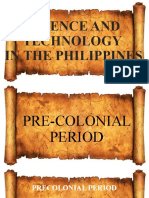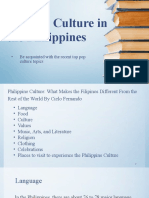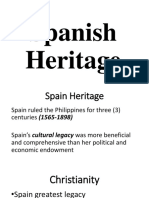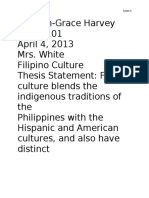0 ratings0% found this document useful (0 votes)
129 viewsOverview of Philippine Cuisine: History, Geographic and Trade Influence, and Famous Cuisine
Overview of Philippine Cuisine: History, Geographic and Trade Influence, and Famous Cuisine
Uploaded by
Jhasie balbinThe document provides an overview of the history and influences on Philippine cuisine. It discusses how rice cultivation began 3400 BC during migrations from Indonesia and Vietnam. Chinese influence in the 2nd century AD introduced soy sauce, fish sauce, and stir frying. Spanish influence in the 16th century brought cutlery, stuffed meats, paella, and Christmas traditions. American influence in the 1940s popularized boodle fights and introduced convenience foods. Today, Philippine cuisine remains influenced by Chinese, Spanish, and American traditions as well as native ingredients like fish, rice, and tropical fruits.
Copyright:
© All Rights Reserved
Available Formats
Download as PPTX, PDF, TXT or read online from Scribd
Overview of Philippine Cuisine: History, Geographic and Trade Influence, and Famous Cuisine
Overview of Philippine Cuisine: History, Geographic and Trade Influence, and Famous Cuisine
Uploaded by
Jhasie balbin0 ratings0% found this document useful (0 votes)
129 views32 pagesThe document provides an overview of the history and influences on Philippine cuisine. It discusses how rice cultivation began 3400 BC during migrations from Indonesia and Vietnam. Chinese influence in the 2nd century AD introduced soy sauce, fish sauce, and stir frying. Spanish influence in the 16th century brought cutlery, stuffed meats, paella, and Christmas traditions. American influence in the 1940s popularized boodle fights and introduced convenience foods. Today, Philippine cuisine remains influenced by Chinese, Spanish, and American traditions as well as native ingredients like fish, rice, and tropical fruits.
Original Description:
TEMPLATE
Original Title
160419 Cookery Template 16x9
Copyright
© © All Rights Reserved
Available Formats
PPTX, PDF, TXT or read online from Scribd
Share this document
Did you find this document useful?
Is this content inappropriate?
The document provides an overview of the history and influences on Philippine cuisine. It discusses how rice cultivation began 3400 BC during migrations from Indonesia and Vietnam. Chinese influence in the 2nd century AD introduced soy sauce, fish sauce, and stir frying. Spanish influence in the 16th century brought cutlery, stuffed meats, paella, and Christmas traditions. American influence in the 1940s popularized boodle fights and introduced convenience foods. Today, Philippine cuisine remains influenced by Chinese, Spanish, and American traditions as well as native ingredients like fish, rice, and tropical fruits.
Copyright:
© All Rights Reserved
Available Formats
Download as PPTX, PDF, TXT or read online from Scribd
Download as pptx, pdf, or txt
0 ratings0% found this document useful (0 votes)
129 views32 pagesOverview of Philippine Cuisine: History, Geographic and Trade Influence, and Famous Cuisine
Overview of Philippine Cuisine: History, Geographic and Trade Influence, and Famous Cuisine
Uploaded by
Jhasie balbinThe document provides an overview of the history and influences on Philippine cuisine. It discusses how rice cultivation began 3400 BC during migrations from Indonesia and Vietnam. Chinese influence in the 2nd century AD introduced soy sauce, fish sauce, and stir frying. Spanish influence in the 16th century brought cutlery, stuffed meats, paella, and Christmas traditions. American influence in the 1940s popularized boodle fights and introduced convenience foods. Today, Philippine cuisine remains influenced by Chinese, Spanish, and American traditions as well as native ingredients like fish, rice, and tropical fruits.
Copyright:
© All Rights Reserved
Available Formats
Download as PPTX, PDF, TXT or read online from Scribd
Download as pptx, pdf, or txt
You are on page 1of 32
Overview of Philippine Cuisine
History, Geographic and Trade Influence, and Famous Cuisine
What did you for breakfast?
Filipino Cuisine
HISTORY
• 3400 BC
• The earliest evidence of rice in the
Philippines was found in the Cagayan
Valley. Rice was brought to the Philippines
during an Indo-Malaysia, Chinese, and
Vietnamese wave of migration.
• 2nd century AD
• The Chinese were the first to trade with the
Philippines, which they called Mal at the
time. China introduced the Philippines to
soy sauce, fish sauce, and the method of
stir frying. This led to the birth of many
Filipino-Chinese dishes such as pansit,
lumpia, siopao, and siomai.
• 1100 AD
• The Philippines began trading with India,
Thailand, and Japan. This led to the
creation of many new Filipino dishes with
spices and flavors from around the world.
• March 16, 1521 - Ferdinand Magellan
landed and coined the islands the Islas de
Poniente.
• 1542 - Spanish explorer Roy López de
Villalobos renamed the islands Felipinas
(Philippines) after King Philip II, who was
prince at the time.
• 16th Century
• The Spanish introduced Filipinos, who
previously ate with their hands and
banana leaves, to cutlery. They also
brought Christmas feast traditions such as
relleno, which is the process of stuffing a
turkey or chicken, rice-meat dishes such as
paella and stews to the Philippines.
• 1896-1898 - The Philippine Revolution,
directed against Spain, took place. This
influenced the nationalist movements of
other Asian countries including China,
Indonesia, and Malaysia
• 1898 - The Philippines was ceded to the
United States by Spain, along with Puerto
Rico and Guam, following the Spanish-
American War
• 19th century
• Many restaurants were established in the
Philippines serving Chinese food with
Spanish names, a result of both the
Chinese and Spanish governorships
throughout history
• 1940s-1950s
• The U.S. Army introduced the concept of a
boodle fight to the Philippines, which is a
militaristic style of eating where all the
food is spread out on a table covered with
banana leaves and eaters stand shoulder-
to-shoulder to stuff their faces as fast as
they could.
• 1950s
• Home Economic classes were introduced
into Filipino schools by Americans, and the
textbook, Housekeeping: A Textbook Guide
for Girl in the Public Intermediate Schools
of the Philippines taught how utensils
should be used.
• 20th century
• The turo-turo and carinderia, both styles
of filipino restaurants, became popular
both in and out of the Philippines, that
served "cheap, filling dishes" that were
popular among locals.
• 20th century
• When Americans came to the Philippines,
they brought iconic American foods, like
burgers, in addition to technology like the
microwave and fridge
• 2016
• Filipino-American chef Tom Cunanan's
restaurant in Washington D.C., Bad Saint,
was named second best new restaurant in
America by Bon Appetit.
• June 9, 2017
• Anthony Bourdain predicts the explosion
of Filipino food in the US, comparing it to
the popularity Korean food gained in the
last decade."I think Filipinos embraced
America and were embraced by America in
a way that other cultures might not have
been," said Bourdain.
GEOGRAPHIC AND TRADE INFLUENCE
• As a country surrounded by water and
islands blessed with fertile soil, early Filipinos
ventured out in the sea for a rich catch, into
muddy rice paddies to plant rice or into the
woods to hunt for abundant wildlife.
• The harvest and catch were cooked in simple
manner: boiled, steamed, roasted or broiled
over an open fire.
• Soy sauce (toyo)
• Fish sauce (patis)
• Stir frying and soup
• Vinegar and spices
• For preservation
• Chinese
• Filipino-Chinese Food
• pancit are noodles that come in various
forms such as bihon, Canton, miki or
sotanghon
• lumpia are vegetables rolled in edible
wrappers
• siopao are steamed, filled buns
• siomai are dumplings.
• Stews such as the cocido and puchero,
rice-meat dishes
• elaborate desserts such as brazos, and
tortas imperiales are generally
considered fiesta food, and most often
found on the dining tables of the
upper classes.
• Paella, the dish cooked in the fields by
Spanish workers, came to be a festive dish
combining pork, chicken, seafood, ham,
sausages and vegetables.
• Relleno, the process of stuffing festive
capons and turkeys for Christmas, was
applied to chicken, and even to bangus,
the Philippine milkfish.
• Christmas, a new feast for Filipinos
that coincided with the rice harvest,
came to feature not only the myriad
native rice cakes, but also
ensaymadas.
• American influence did not only bring their
staple food of burgers, pies and salads.
• The Americans introduced to the
Philippine cuisine the ways of
convenience: pressure-cooking, freezing,
pre-cooking, sandwiches and salads;
hamburgers, fried chicken and steaks.
TOP 10 FILIPINO FOOD
10. Fish tinola
9. Arroz Caldo
8. Bulalo
You might also like
- Master Chef Competition Planning ChecklistDocument4 pagesMaster Chef Competition Planning ChecklistNeelesh Kadam100% (1)
- History of Philippine CuisineDocument2 pagesHistory of Philippine CuisineManny MontalaNo ratings yet
- History of FoodserviceDocument10 pagesHistory of Foodservicejaydaman08No ratings yet
- Chapter 2 - Science & Technology in The PHDocument58 pagesChapter 2 - Science & Technology in The PHAdrian Valderama100% (2)
- Cultural Changes and IdentityDocument12 pagesCultural Changes and IdentityLawrence Bucayu0% (1)
- Apartment C.08.1 Candy & CandyDocument45 pagesApartment C.08.1 Candy & CandyShane CroucherNo ratings yet
- Nred Active HoaDocument620 pagesNred Active HoaAlyssa Mae Coloma-CasimiroNo ratings yet
- History of Food ServiceDocument4 pagesHistory of Food ServiceJoHoneyBoyles100% (1)
- 7 8 Philippine Cusine and Korean CuisineDocument62 pages7 8 Philippine Cusine and Korean CuisineEthel JezmariNo ratings yet
- Philippine GastronomyDocument40 pagesPhilippine GastronomyLander Lausin100% (2)
- What Is The American Cuisine?Document27 pagesWhat Is The American Cuisine?Jomarie RamirezNo ratings yet
- Philippine Gastronomy Prelim Reviewer: Gastronomic Tourism RefersDocument2 pagesPhilippine Gastronomy Prelim Reviewer: Gastronomic Tourism Refersmvlg26No ratings yet
- Lesson 3 Antonio Pigafetta and Spanish ColonizationDocument52 pagesLesson 3 Antonio Pigafetta and Spanish ColonizationElaric MarasiganNo ratings yet
- Popula R Cuisine in The Philipp Ines: By: Dan Sis On Lea Maie M Anansala Geraldine M ArcosDocument47 pagesPopula R Cuisine in The Philipp Ines: By: Dan Sis On Lea Maie M Anansala Geraldine M Arcosあ 運No ratings yet
- American CuisineDocument6 pagesAmerican CuisineMotopatz BrionesNo ratings yet
- Wk15 Western Food Culture (USA)Document36 pagesWk15 Western Food Culture (USA)Jerlyn AngNo ratings yet
- History of FoodserviceDocument6 pagesHistory of FoodserviceSharina Canaria ObogNo ratings yet
- Food ServiceDocument5 pagesFood ServiceAlnico SantosNo ratings yet
- Research PaperDocument20 pagesResearch Paperanje10100% (2)
- American CuisineDocument49 pagesAmerican CuisineRegena GuladaNo ratings yet
- @@@@Document22 pages@@@@alvin balisbisNo ratings yet
- A Cultural Investigation Around The World - The PhilippinesDocument30 pagesA Cultural Investigation Around The World - The PhilippinesAreebah QureshiNo ratings yet
- Introduction To Filipino Cuisine Hand OutsDocument10 pagesIntroduction To Filipino Cuisine Hand OutsJennifer Balais PausalNo ratings yet
- Phil - History (1) Balondo GroupDocument5 pagesPhil - History (1) Balondo GroupJovy Mae PastorNo ratings yet
- Science and Technology in the PhilippinesDocument36 pagesScience and Technology in the PhilippinesFernando RosillonNo ratings yet
- Module 3 History and InfluencesDocument7 pagesModule 3 History and Influencescarpioshane686No ratings yet
- Chapter 1 Introduction To Filipino and Regional CuisineDocument9 pagesChapter 1 Introduction To Filipino and Regional CuisineGraceCayabyabNiduaza100% (1)
- The Philippines: Culture and Tradition: LanguageDocument4 pagesThe Philippines: Culture and Tradition: LanguageAlvie MontejoNo ratings yet
- Gelly-An FAjardoDocument33 pagesGelly-An FAjardoGelly-An FajardoNo ratings yet
- Filipino Culture and TraditionsDocument4 pagesFilipino Culture and TraditionsLJ UretaNo ratings yet
- With 7Document2 pagesWith 7nekirynNo ratings yet
- Filipino Cuisine Thru The YearsDocument4 pagesFilipino Cuisine Thru The YearsPatricia MarieNo ratings yet
- Spanish PeriodDocument110 pagesSpanish PeriodFreshie PascoNo ratings yet
- Filipino Fusion Cuisine InfluencesDocument15 pagesFilipino Fusion Cuisine InfluencesHindrick Jumawan100% (1)
- Philippine Popular Culture (PPC) (Weeks 3-5)Document24 pagesPhilippine Popular Culture (PPC) (Weeks 3-5)Mei MeiNo ratings yet
- Midterm: Lesson 1: History of The Philippines FoodDocument8 pagesMidterm: Lesson 1: History of The Philippines FoodRio CamoniasNo ratings yet
- Review - Philippine Arch Pre SpanishDocument39 pagesReview - Philippine Arch Pre SpanishiloilocityNo ratings yet
- Indian CuisineDocument4 pagesIndian CuisineBrij GohilNo ratings yet
- Science and Technology in The PhilippinesDocument48 pagesScience and Technology in The PhilippinesChristian ArellanoNo ratings yet
- Reading in The Philippine History PPT2Document20 pagesReading in The Philippine History PPT2Jacq Angelica Eunice SulitNo ratings yet
- Phil. Regional Cuisine and Food Styling Design PrelimDocument62 pagesPhil. Regional Cuisine and Food Styling Design Prelimbampalaganas.pimsatNo ratings yet
- Spanish HeritageDocument26 pagesSpanish HeritageLovelyJoyceGarciaNo ratings yet
- Colonial PeriodDocument9 pagesColonial Periodrahmahanwar543No ratings yet
- Philippine Culture: Middle Spanish PeriodDocument3 pagesPhilippine Culture: Middle Spanish PeriodJojemar EncisoNo ratings yet
- Spanish RuleDocument28 pagesSpanish RuleDanica Christele AlfaroNo ratings yet
- Spanish era-WPS OfficeDocument3 pagesSpanish era-WPS Officekattlenedabas0% (1)
- Lesson 2 - 19th Century Philippines As Rizal's ContextDocument21 pagesLesson 2 - 19th Century Philippines As Rizal's ContextCindy Graze EscaleraNo ratings yet
- PRELIM-S-T-IN-THE-PHILIPPINES (1)Document37 pagesPRELIM-S-T-IN-THE-PHILIPPINES (1)markdanieljayaNo ratings yet
- VED 3 Lesson 1Document9 pagesVED 3 Lesson 1Xzyl Dawn SingsonNo ratings yet
- The Country and The PeopleDocument16 pagesThe Country and The PeopleMark Joshua CequeñaNo ratings yet
- Week 2 - Historical BanquetingDocument51 pagesWeek 2 - Historical BanquetingKrystelle Mae Salas AbuyogNo ratings yet
- History of AtoleDocument4 pagesHistory of AtoleYesenia CastroNo ratings yet
- Mexican Influences On Philippine CultureDocument5 pagesMexican Influences On Philippine CultureAnonymous w0S5PvzNo ratings yet
- CPARDocument3 pagesCPARkimarvinarellanoNo ratings yet
- Magellan's VoyageDocument3 pagesMagellan's VoyageAlyanna DimayugaNo ratings yet
- Asian - Lesson 2Document23 pagesAsian - Lesson 2Jasmine BalbinNo ratings yet
- Amrican Cuisine2023Document43 pagesAmrican Cuisine2023sham ibrahimNo ratings yet
- Informative Speech OutlineDocument12 pagesInformative Speech OutlineCaylaNo ratings yet
- Filipino: ServicesDocument41 pagesFilipino: ServicesBethena SamanthaNo ratings yet
- Cultural Elements of The PhilippinesDocument4 pagesCultural Elements of The PhilippinesJohn Lorenze ValenzuelaNo ratings yet
- Gned 09 Quiz Bee - 071026Document4 pagesGned 09 Quiz Bee - 071026paulgeorgepadil0No ratings yet
- American HeritageDocument3 pagesAmerican Heritageclairemission123No ratings yet
- Experience the Philippines : Culture, Cuisine, and Natural Wonders UnveiledFrom EverandExperience the Philippines : Culture, Cuisine, and Natural Wonders UnveiledNo ratings yet
- Abdan Development Sdn. Bhd. Tile Size No. Item Size NoteDocument1 pageAbdan Development Sdn. Bhd. Tile Size No. Item Size NoteAfham BunkerzNo ratings yet
- TLE 7 and 8 Cookery Week1 2Document6 pagesTLE 7 and 8 Cookery Week1 2Ann A.No ratings yet
- Struktur Organisasi RHBDocument1 pageStruktur Organisasi RHBiksan rmdnNo ratings yet
- Heat Reclaim Ventilator VKMDocument2 pagesHeat Reclaim Ventilator VKMcodefinderNo ratings yet
- Building Permit Requirements: Community Development DepartmentDocument1 pageBuilding Permit Requirements: Community Development DepartmentDavid MacKenzieNo ratings yet
- Cagayat PortfolioDocument20 pagesCagayat PortfolioYoan CagayatNo ratings yet
- Qbake - Production Planning GuideDocument25 pagesQbake - Production Planning GuideahetNo ratings yet
- Room Inspection Checklist: SL No: Date: Room Attandant: Room No: Floor Supervisor: Remarks SignatureDocument4 pagesRoom Inspection Checklist: SL No: Date: Room Attandant: Room No: Floor Supervisor: Remarks SignatureSteven ReedNo ratings yet
- I .Bed: My Name Is Andrea. - Am Eleven Years OldDocument3 pagesI .Bed: My Name Is Andrea. - Am Eleven Years OldJOSE LUISNo ratings yet
- Summary Slide: Figure 11-1Document15 pagesSummary Slide: Figure 11-1Emmanuel CherianNo ratings yet
- Blue Energy Private Limited Super Trishuli Hydropower Proejct Construction of Field Camp-1Document4 pagesBlue Energy Private Limited Super Trishuli Hydropower Proejct Construction of Field Camp-1DipeshNo ratings yet
- Masters Bedroom & BathroomDocument1 pageMasters Bedroom & Bathroomjoshua palizaNo ratings yet
- SL NO Complaint # Type Date & Time Description Location StatusDocument2 pagesSL NO Complaint # Type Date & Time Description Location StatusRaziKhanNo ratings yet
- Poultry and Poultry CookeryDocument39 pagesPoultry and Poultry CookeryNomar MercinesNo ratings yet
- Soal Bahasa Inggris Kelas 4 My Living Room Is Beside KitchenDocument5 pagesSoal Bahasa Inggris Kelas 4 My Living Room Is Beside KitchenSilvia Nur FitrianaNo ratings yet
- Flat 1 & 2 Modified PDFDocument1 pageFlat 1 & 2 Modified PDFSalahuddin ShaikhNo ratings yet
- Shopping Basket - IKEA PDFDocument4 pagesShopping Basket - IKEA PDFPanNo ratings yet
- Q3 TLE 9 Tools Utensils and Equipment in Preparing SandwichesDocument7 pagesQ3 TLE 9 Tools Utensils and Equipment in Preparing SandwichesAshlee Ashlee50% (2)
- Construction Scope of Work TemplateDocument2 pagesConstruction Scope of Work TemplatealanNo ratings yet
- Plumbing Materials, Traps, Ventilation, Fixtures and InstallationDocument3 pagesPlumbing Materials, Traps, Ventilation, Fixtures and InstallationAldea ChanNo ratings yet
- Lesson 7 - HK2Document20 pagesLesson 7 - HK2Nina Rica PesiganNo ratings yet
- I. Từ Vựng Ielts Chủ Đề Flats/ Home/ Accommodation: e.g. a two-bedroom flatDocument7 pagesI. Từ Vựng Ielts Chủ Đề Flats/ Home/ Accommodation: e.g. a two-bedroom flatJYS IELTSNo ratings yet
- Unit 14. - Are There Any Posters in The RoomDocument7 pagesUnit 14. - Are There Any Posters in The RoomTrang NguyenNo ratings yet
- Useful Piping & Structural DataDocument159 pagesUseful Piping & Structural DatamsaremiNo ratings yet
- Layout of HKDocument33 pagesLayout of HKNanjappa BabuNo ratings yet
- English OlaDocument17 pagesEnglish OlaEvi Atikah SariNo ratings yet
- Moulinex AM 7000Document10 pagesMoulinex AM 7000Stein Hjalmar HansenNo ratings yet

























































































